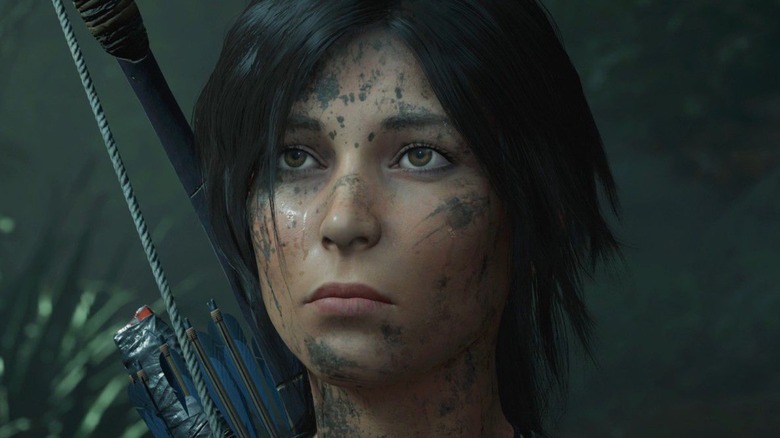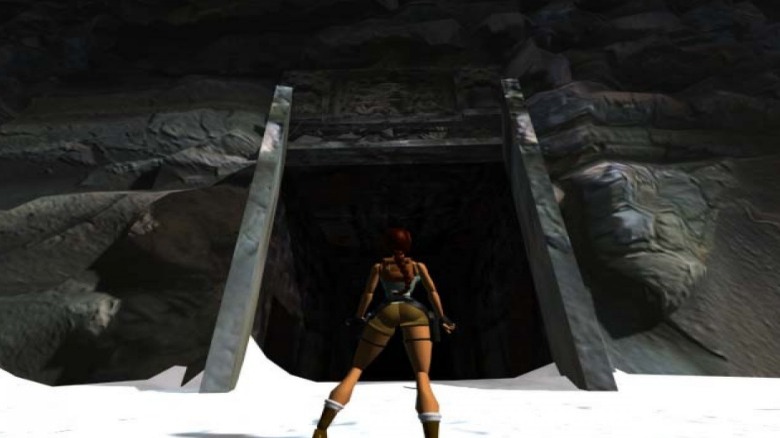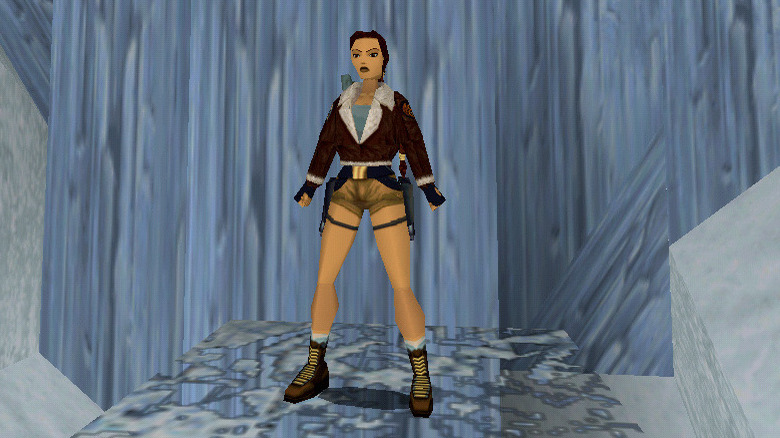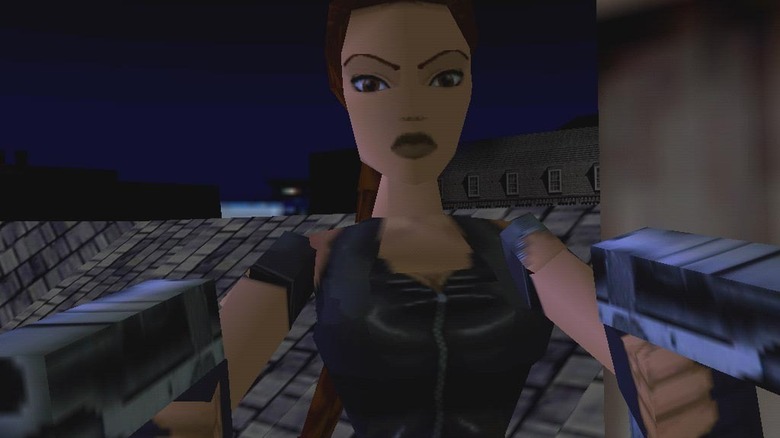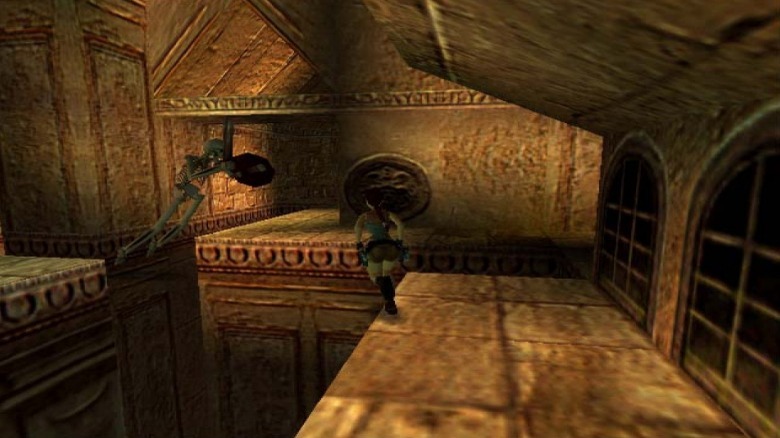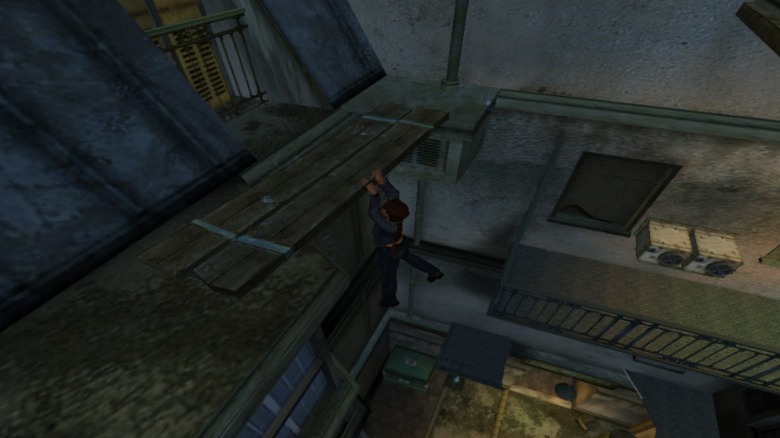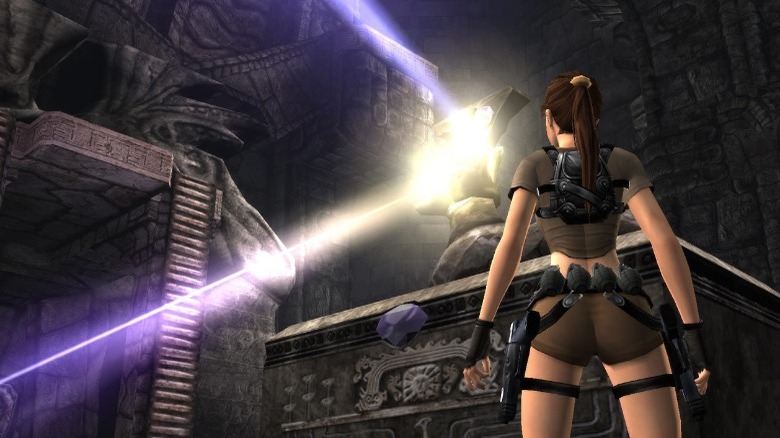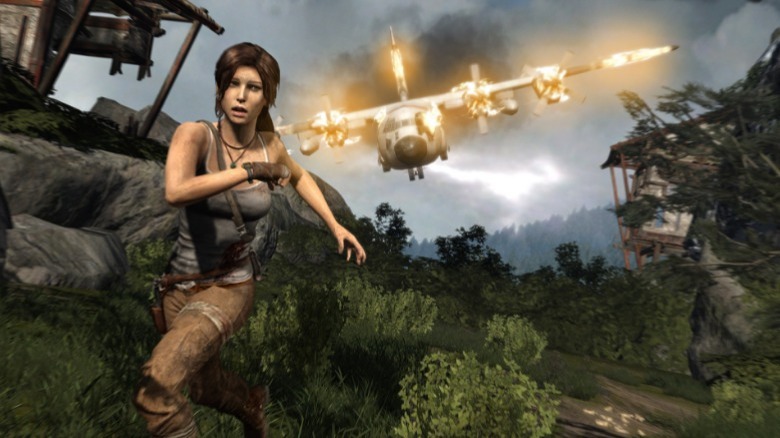Why The Tomb Raider Games Have Had 5 Different Lara Croft Actors
Lara Croft from "Tomb Raider" is arguably the most iconic female character in video game history. Even when she ditches her signature dual handguns, teal tank top, and braided ponytail, almost every gamer on the planet instantly recognizes her. But can they recognize her voice?
Fans definitely know her personality, but they may struggle with her voice, since she's arguably never had a singular voice actress to make audiences instantly say, "Yeah, this is my Lara Croft." At least, not until fairly recently.
You don't have to dig deep into video game industry vaults to discover that studios often have a problem with voice actor retention. Many actors have been hired to voice one character in one game and then swapped out for someone else, and Lara Croft is no exception. She has been through five different actresses, not including her various movie and upcoming Netflix anime portrayals. Some have stayed around longer than others, but the game series has still swapped out actresses more often than Lara herself swaps out ammo clips.
Here's why these voices haven't stuck around to portray video game's leading lady from start to finish.
In the beginning
Every new video game franchise needs a face with a memorable personality for fans to latch onto. The developers at Core Design encountered this daunting task when starting the "Tomb Raider" series, as the studio didn't just have to decide how Lara Croft would look and act, but also how she sounded.
You may have already heard the popular tale of Lara Croft's birth. Core Design employee Toby Gard dreamt up a video game starring a male adventurer raiding ancient tombs, but concerns were raised regarding similarities between the protagonist and Indiana Jones, so the character was changed to a woman, who eventually became Lara Croft — except that's not what happened. According to an interview with the head Core Design staff, Gard always envisioned Lara as a woman. Early designs were more Private Vasquez from "Aliens" than British archaeologist, but she was, in fact, always a she. Regardless, since Gard wanted to make the game an "interactive movie," the character needed a voice.
Core Design searched for nine months, but nobody seemed to fit. Then one day, Shelley Blond, a newcomer to the voice acting world, heard about the project, sent in an audition tape, and landed the role in a matter of days. That's a lot of work for ended up being a five-hour gig, but she still left an impact. While Blond didn't record new lines for subsequent games (contractual obligations got in the way), Core Design recycled her soundbites for the next two entries — with her blessing, of course.
Should a company ever remaster the first "Tomb Raider" game, Blond would gladly rerecord all of her lines. Until then, her voice can be heard in 2022 mobile game "Tomb Raider Reloaded."
It's not what you know, but who you know
When applying for a job, it's easy to assume the odds are stacked against you, because they typically are. You need to prove yourself to complete strangers, unless friends and family can vouch for your skills — or at the very least tell you when a company is looking for a new hire.
Since Shelley Blond's contractual obligations prevented her from continuing any Lara Croft work at the time, Core Design needed a new actress to play the character in the sequel ASAP, and one of the hopefuls was Judith Gibbins, who had never seen or heard of Lara Croft before.
As Gibbins told Lara Croft PT, through some cosmic stroke of luck, her brother, Martin Gibbins, was a programmer at Core Design and told her the company was holding auditions for voice talent. When Judith arrived, she had to out-perform eight other applicants, so you might assume she asked her brother for advice on how the character should sound. Instead, she asked what Lara Croft looked like, which proved to be just what she needed.
As history demonstrates, Judith wowed the Core Design team and went on to voice Lara Croft for the second and third "Tomb Raider" titles. While some have claimed she auditioned to play Lara in the fourth game (and lost), Judith says otherwise. Still, that doesn't mean she has washed her hands of Lara. Like Blond, Judith is returning for "Tomb Raider Reloaded."
New game, new team, new problems
When a video game sells well, sequels are usually not far behind, and "Tomb Raider" sold really well. Not only did the game's publisher, Eidos, want a new "Tomb Raider" game, it wanted it within a year. What was initially a surprise success for Core Design turned into a chore that ate away at morale.
Core Design had given 10 scant months to produce "Tomb Raider 2," so the company brought in some new people to speed up the process. While these fresh faces let the company produce levels faster, one veteran didn't return: Toby Gard. As he explained to Gamasutra, he was frustrated over losing creative control of Lara Croft, so he left the company. Oh, and he also didn't like "Tomb Raider" ads playing up Lara's sex appeal.
These production concerns continued after "Tomb Raider 2." Core Design wanted to spend two years on "Tomb Raider 3" to make it extra special. And, while a chunk of the Core Design team worked on that project, a splinter group led by designer Richard Morton toiled over an expansion, dubbed "Tomb Raider 2 ½." But, Eidos told the team to scratch the expansion and turn it into "Tomb Raider 3" proper, complete with a shorter turnaround. As programmer Gavin Rummery put it, the publisher didn't believe anyone bought "DLC type things." Oh, how times have changed.
After everything was said and done with "Tomb Raider 2" and "3," developers at Core Design were feeling exhausted. This would become a recurring theme with the studio and the franchise as a whole — and it eventually would lead to another recasting.
From tomb raider to tomb resident
In the world of entertainment, you either end your franchise a hero or live long enough to see yourself become creatively bankrupt. Imagination exhaustion is a very real problem, and when you have done everything you think you can do with a story and its characters, where do you go from there? In the case of "Tomb Raider," you try to end it on your own terms — the key word being "try."
Because Core Design felt pressured to turn "Tomb Raider" into an annual series, developers essentially worked non-stop for several years on end. That's good news for gamers, but bad news for employees. This ceaseless schedule "ruined" the lives of several Core Design team members and pushed them to the brink of mental breakdown. The dev team was feeling burnt out by the time it finished "Tomb Raider 2," which isn't conducive to producing several more sequels. The developers were out of ideas for Lara Croft and wanted to start work on a new project, so they killed her at the end of "Tomb Raider: The Last Revelation" by — burying her in a tomb. What an ironic end.
Unfortunately, Lara Croft didn't take kindly to early retirement — or to be more specific, Eidos didn't take kindly to Core Design's attempt to retire Lara. Rather than letting Core work on something new, Eidos wanted yet another sequel, "Tomb Raider Chronicles." But instead of creating new adventures for Lara, Core Design decided to keep her dead and produce a game recounting her earlier, never-before-seen adventures. Reviewers were less than pleased, and the most critical ones would have preferred if Lara had stayed gone.
Angel of Darkness was the end of an era
After Judith Gibbins left, Core Design needed another voice actress for Lara Croft. Again. This time, the studio reached out to several voice artists, including Jonell Elliott. As Elliott told Raidercast, she gave it her all, implementing advice from Shelley Blond (with whom Elliott had worked on a musical) and nailing the part. Had things gone according to Core Design's plans, hers would have been a one-game gig. Instead, Elliott ended up voicing Lara Croft during some of the character's worst adventures.
After "Tomb Raider: The Last Revelation," game quality decreased with each subsequent entry, culminating in "Tomb Raider: The Angel of Darkness." A new team with no "Tomb Raider" experience was brought in to make that game (per IGN), which explains many of its problems; its rushed release schedule to hit store shelves before the second "Tomb Raider" movie explains many more. The end result was a mess of bugs and half-implemented ideas. Even Core Design's co-founder, Jeremy Heath-Smith, couldn't pull off "simple" game mechanics without cursing (and in front of a live audience, no less).
Not only is "Tomb Raider: The Angel of Darkness" widely regarded as the lowest point in the franchise, it also ended "Tomb Raider" as audiences knew it. The game was so bad that Heath-Smith resigned from the game industry (or was fired; accounts differ, according to Polygon), and Eidos handed "Tomb Raider" production rights over to Crystal Dynamics.
Snatching the "Tomb Raider" name from the devs that birthed it (and ran themselves into the ground trying to perpetuate it) might seem unwise, but it gave the franchise newfound success.
Tomb Raider's return to form
Since Crystal Dynamics had never produced a "Tomb Raider" title before Eidos passed it the IP, the studio had its work cut out for it. How could Crystal Dynamics revitalize a franchise that even its own creators thought was getting too long in the tooth several years ago? By trying to recapture the original magic — specifically by recruiting the people behind said magic.
Crystal Dynamics hired Toby Gard (per Digital Trends) to serve as a consultant for the studio's first outing with Lara Croft, "Tomb Raider: Legend." Gard wore many hats during the game's production, from co-writer to cinematic director, and he also had made sure subsequent entries sported his fingerprints. More importantly, he also oversaw the character design of the game's main hero. But this new Lara Croft still needed one more element: a voice.
Keeley Hawes ended up voicing Lara Croft throughout the Crystal Dynamics reboot saga. She even portrayed the adventurer in spin-off titles such as "Lara Croft and the Guardian of Light" and "Lara Croft and the Temple of Osiris," but history almost took a very different turn. According to an interview with Shelley Blond, Crystal Dynamics asked her to audition for the rebooted Lara, and it ultimately came down to a choice between her and Hawes.
Hawes won, but there was no love lost because Blond thinks she has a "gorgeous voice, very fitting for the Lara Character." Now, for the first time in a long time, Gard was back at the helm, and the developer had no plans on letting go of the series' new star.
Reboot, take two
The overall quality of the "Tomb Raider" games improved drastically after Crystal Dynamics got its hands on the franchise, and critics were happy — but the honeymoon didn't last forever. "Tomb Raider: Underworld" sales numbers fell short of expectations, which made Eidos shares drop by 30% (per GameSpot). Two months later, Square Enix bought Eidos. Coincidence? Perhaps, but the purchase still gave Square Enix ownership of "Tomb Raider" and its then-in-production reboot. Yes, Crystal Dynamics rebooted the franchise twice, which necessitated yet another new voice for Lara Croft.
Two years after Square Enix officially announced the new "Tomb Raider" game, the company revealed that after scouring the world, Camilla Luddington would be the new voice for Lara. Unlike past leading ladies who were kept under wraps, Luddington's involvement was a crucial part of the ad campaign, and Luddington stayed on for the reboot series' entirety, unlike the brief involvement of some of Lara's previous voice actors.
Of course, all good things must come to an end (again), which might have already happened to Luddington's tomb raiding tenure. During an interview with Entertainment Tonight, she claimed that she looked at her work on the franchise as a trilogy, with "Shadow of the Tomb Raider” possibly marking the finale. That doesn't mean the reboot trilogy won't turn into a quadrilogy — or that Luddington wouldn't return for a hypothetical fourth game — just that audiences shouldn't be surprised if they hear a new voice coming from Lara Croft in the near future.

